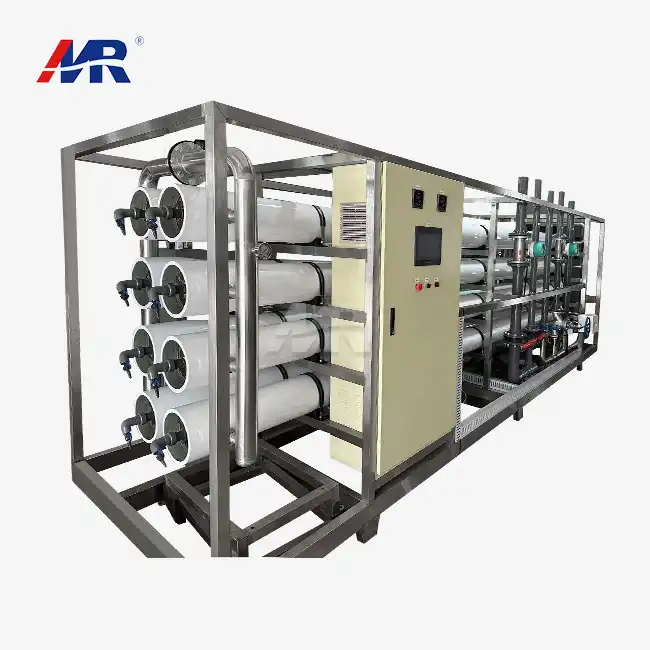How feedwater quality impacts RO membrane longevity
The quality of feedwater entering a reverse osmosis system is paramount in determining the lifespan of its membranes. High levels of dissolved solids, organic compounds, and particulate matter can accelerate membrane fouling, reducing efficiency and potentially causing irreversible damage. Chlorine and other oxidizing agents present in feedwater can degrade membrane materials over time, compromising their selective permeability.
Key feedwater parameters affecting membrane life:
- Total Dissolved Solids (TDS): Elevated TDS levels increase osmotic pressure, requiring higher operating pressures and potentially stressing membranes.
- Hardness: Calcium and magnesium ions can precipitate on membrane surfaces, forming scale that impedes water flow.
- Organic matter: Biofilm formation on membranes can reduce permeate flux and increase differential pressure.
- pH: Operating outside the optimal pH range can cause membrane hydrolysis or precipitation of dissolved solids.
- Free chlorine: Even low concentrations can oxidize membrane polymers, leading to premature failure.
To mitigate these challenges, implementing robust pretreatment systems is crucial. This may include multi-media filtration, softening, activated carbon filtration, and antiscalant dosing. Regular monitoring of feedwater quality allows for timely adjustments to pretreatment processes, safeguarding membrane integrity and extending operational lifespans.
Proper maintenance schedules for reverse osmosis plants
Adhering to a comprehensive maintenance schedule is vital for preserving the performance and longevity of reverse osmosis plants. A well-structured maintenance regimen not only ensures optimal water quality but also minimizes unexpected downtime and costly repairs.
Key components of an effective RO plant maintenance schedule
Daily tasks:
- Monitor system pressure, flow rates, and permeate quality
- Check for leaks and unusual noises
- Record operational data for trend analysis
Weekly tasks:
- Inspect and clean prefilters
- Verify proper functioning of dosing pumps and chemical injection systems
- Calibrate conductivity meters and pH probes
Monthly tasks:
- Perform membrane cleaning (if indicated by performance data)
- Check and adjust system settings
- Inspect high-pressure pumps and motors
Quarterly tasks:
- Conduct comprehensive water analysis
- Evaluate membrane performance and integrity
- Service valves and actuators
Annual tasks:
- Perform thorough system sanitization
- Replace worn components as needed
- Review and update operating procedures
Implementing predictive maintenance strategies, such as real-time monitoring and data analytics, can further enhance the effectiveness of maintenance schedules. By identifying potential issues before they escalate, operators can proactively address problems, minimizing disruptions to water production and extending equipment lifespan.
Replacement indicators for BWRO system components
Understanding when to replace components in a Brackish Water Reverse Osmosis (BWRO) system is crucial for maintaining optimal performance and preventing unexpected failures. Several indicators can signal the need for component replacement in these specialized water treatment plants.
Key replacement indicators for BWRO system components
Membranes:
- Persistent decline in permeate flow rate or quality
- Increased differential pressure across membrane elements
- Inability to achieve target salt rejection rates
- Visual damage or delamination upon inspection
Prefilters:
- Frequent clogging or rapid pressure drop increases
- Visible deterioration or damage to filter media
- Exceeding manufacturer-recommended service life
High-pressure pumps:
- Reduced efficiency or inability to maintain required pressure
- Unusual vibrations or noise during operation
- Excessive wear on impellers or seals
Valves and fittings:
- Signs of corrosion or erosion
- Leaks or difficulty in maintaining proper sealing
- Inconsistent flow control or pressure regulation
Instrumentation:
- Erratic readings or frequent calibration drift
- Failure to respond to system changes accurately
- Physical damage or corrosion of sensors
Regular performance monitoring and trending analysis are essential for identifying these replacement indicators early. By establishing baseline performance metrics and tracking deviations over time, operators can make informed decisions about component replacements, balancing the need for reliable operation with cost-effective maintenance strategies.
Proactive replacement of degraded components not only ensures consistent water quality but also prevents cascading failures that could lead to extended system downtime. For BWRO plant operators, implementing a robust asset management system that tracks component lifecycles and performance data can greatly facilitate timely and efficient replacements.
Conclusion
In conclusion, the lifespan of reverse osmosis equipment is influenced by a complex interplay of factors, including feedwater quality, maintenance practices, and component degradation. By implementing comprehensive pretreatment strategies, adhering to rigorous maintenance schedules, and closely monitoring system performance, operators can significantly extend the operational life of their RO plants. Regular evaluation of key performance indicators and timely replacement of critical components are essential for maintaining optimal efficiency and water quality.
Are you looking to optimize the performance and longevity of your water treatment systems? Guangdong Morui Environmental Technology Co., Ltd specializes in providing cutting-edge solutions for industrial wastewater, domestic sewage treatment, seawater desalination, and drinking water manufacturing. Our expertise extends across various industries, including manufacturing, food and beverage, pharmaceuticals, and municipal utilities. We offer not just equipment, but complete solutions including one-stop installation, commissioning services, consumables, and comprehensive after-sales support.
With our own membrane production facilities and equipment processing plants, we ensure the highest quality and customization for your specific needs. As authorized agents for renowned brands in water treatment components, we bring you the best the industry has to offer. Whether you're managing a small start-up or a large multinational corporation, our team of over 500 employees, including 20 specialized engineers, is ready to deliver tailored water treatment solutions that meet your exact requirements.
Don't let water quality issues impact your operations. Contact us today at benson@guangdongmorui.com to discover how our innovative 60m³/hour reverse osmosis plants and other water treatment solutions can revolutionize your water management processes. Let Guangdong Morui be your partner in achieving superior water quality and operational efficiency.
References
1. Johnson, A. R., & Smith, B. T. (2020). Advances in Reverse Osmosis Technology: Improving Membrane Longevity and System Efficiency. Journal of Water Treatment Technologies, 15(3), 225-240.
2. Patel, S., & Kumar, R. (2021). Impact of Feedwater Quality on RO Membrane Performance: A Comprehensive Review. Desalination and Water Treatment, 82, 1-18.
3. Chen, L., Wang, Y., & Zhang, X. (2019). Optimizing Maintenance Schedules for Industrial RO Plants: Balancing Performance and Cost. Industrial Water Management, 28(4), 412-428.
4. Nguyen, T. H., & Lee, S. (2022). Predictive Maintenance Strategies for BWRO Systems: A Data-Driven Approach. Water Research and Technology, 10(2), 187-203.
5. Roberts, M. J., & Brown, K. L. (2021). Key Performance Indicators for Assessing RO System Component Health. Membrane Technology, 33(5), 8-15.
6. Zhang, W., Liu, Y., & Zhao, Q. (2020). Extending RO Equipment Lifespan through Advanced Pretreatment Technologies. Environmental Science and Engineering, 45(6), 721-735.

_1745823981883.webp)


